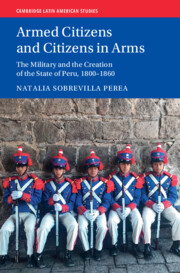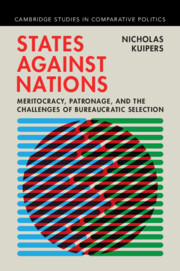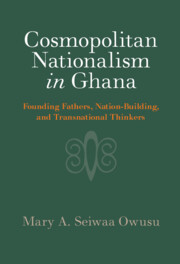Refine search
Actions for selected content:
110 results
Knowledges that Cannot Be Known: Structuring Azerbaijani Attachment to Nagorno-Karabakh
-
- Journal:
- Nationalities Papers , FirstView
- Published online by Cambridge University Press:
- 23 September 2025, pp. 1-23
-
- Article
-
- You have access
- Open access
- HTML
- Export citation

Armed Citizens and Citizens in Arms
- The Military and the Creation of the State of Peru, 1800‒1860
-
- Published online:
- 12 September 2025
- Print publication:
- 25 September 2025

States against Nations
- Meritocracy, Patronage, and the Challenges of Bureaucratic Selection
-
- Published online:
- 14 August 2025
- Print publication:
- 07 August 2025
Language Policies and Insecurities in Ukraine
-
- Journal:
- Nationalities Papers , FirstView
- Published online by Cambridge University Press:
- 13 August 2025, pp. 1-19
-
- Article
-
- You have access
- Open access
- HTML
- Export citation
2 - State-Building, Nation-Building, and a Theory of How Bureaucratic Selection Affects Both
-
- Book:
- States against Nations
- Published online:
- 14 August 2025
- Print publication:
- 07 August 2025, pp 32-74
-
- Chapter
- Export citation
Imperialism and Ethnonationalism in Russia’s Turbulent Years (1989–1994) – How Narratives of Unjust Borders Shaped Putin’s ‘Time Bomb’ Metaphor
-
- Journal:
- Nationalities Papers , FirstView
- Published online by Cambridge University Press:
- 31 July 2025, pp. 1-19
-
- Article
-
- You have access
- Open access
- HTML
- Export citation
Lightning-Sword and Blazing Steed under the Hammer and Sickle: The Rebirth of David of Sassoun in Soviet Armenia
-
- Journal:
- Nationalities Papers , FirstView
- Published online by Cambridge University Press:
- 30 July 2025, pp. 1-27
-
- Article
-
- You have access
- Open access
- HTML
- Export citation
Model Minorities and Fifth Columns in Service of Nation-Building: (De)securitization of Ethnicity in Nation-States with Multiple Minorities
-
- Journal:
- Nationalities Papers , FirstView
- Published online by Cambridge University Press:
- 10 July 2025, pp. 1-21
-
- Article
-
- You have access
- Open access
- HTML
- Export citation
Multinational in Form, Russkii in Content: Explaining Russian Citizens’ Enduring Preference for a Multinational State
-
- Journal:
- Nationalities Papers , FirstView
- Published online by Cambridge University Press:
- 04 July 2025, pp. 1-17
-
- Article
-
- You have access
- Open access
- HTML
- Export citation
Han-Centrism and Multiethnic Nation-Building in China and Taiwan: A Comparative Study since 1911 – CORRIGENDUM
-
- Journal:
- Nationalities Papers , FirstView
- Published online by Cambridge University Press:
- 09 June 2025, p. 1
-
- Article
-
- You have access
- Open access
- HTML
- Export citation
Forgotten voices from the Great War: the Chinese Labour Corps
-
- Journal:
- Asia-Pacific Journal / Volume 13 / Issue 51 / December 2015
- Published online by Cambridge University Press:
- 14 March 2025, e1
-
- Article
-
- You have access
- Open access
- Export citation
‘Exhibit Asia’ and its Deconstruction through Collaborative Online Learning
-
- Journal:
- Transactions of the Royal Historical Society , First View
- Published online by Cambridge University Press:
- 04 March 2025, pp. 1-20
-
- Article
-
- You have access
- Open access
- HTML
- Export citation
Józef Chałasiński’s Research on the Nationalization Process of Peasants in Poland
-
- Journal:
- Nationalities Papers / Volume 53 / Issue 5 / September 2025
- Published online by Cambridge University Press:
- 28 February 2025, pp. 1150-1173
-
- Article
-
- You have access
- Open access
- HTML
- Export citation
Old woods, new rule: the annexation of Veneto to the Kingdom of Italy from a forest history perspective
-
- Journal:
- Modern Italy , First View
- Published online by Cambridge University Press:
- 22 January 2025, pp. 1-14
-
- Article
-
- You have access
- Open access
- HTML
- Export citation

Cosmopolitan Nationalism in Ghana
- Founding Fathers, Nation-Building, and Transnational Thinkers
-
- Published online:
- 12 December 2024
- Print publication:
- 19 December 2024
20 - Homeric Epic and Nation-Building in Modern Greece and Turkey
- from Part VI - Epic Without End
-
-
- Book:
- The Cambridge Companion to Ancient Greek Epic
- Published online:
- 04 December 2024
- Print publication:
- 28 November 2024, pp 422-441
-
- Chapter
- Export citation
Han-Centrism and Multiethnic Nation-Building in China and Taiwan: A Comparative Study since 1911
-
- Journal:
- Nationalities Papers / Volume 53 / Issue 5 / September 2025
- Published online by Cambridge University Press:
- 18 November 2024, pp. 983-1000
-
- Article
-
- You have access
- Open access
- HTML
- Export citation
2 - What Is African Journalism?
- from Part I - Making Journalists
-
- Book:
- In the Shadow of the Global North
- Published online:
- 13 November 2024
- Print publication:
- 07 November 2024, pp 34-47
-
- Chapter
- Export citation
Beyond (Ethno)linguistic Determinism: Diverse Approaches to Nationalism in Habsburg-Austrian Schools
-
- Journal:
- Nationalities Papers , FirstView
- Published online by Cambridge University Press:
- 31 October 2024, pp. 1-13
-
- Article
-
- You have access
- Open access
- HTML
- Export citation
Pork Barrel and Identity Politics: Explaining a Minority Party’s Electoral Success in Lithuania
-
- Journal:
- Nationalities Papers / Volume 53 / Issue 4 / July 2025
- Published online by Cambridge University Press:
- 25 September 2024, pp. 857-876
-
- Article
-
- You have access
- Open access
- HTML
- Export citation
